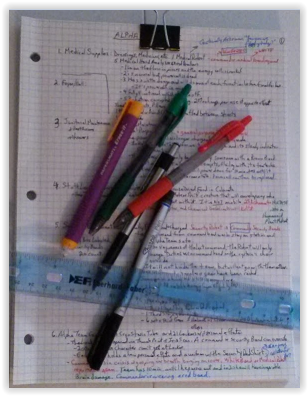When I write up my notes/design for an adventure by hand, I use standard letter size paper and black ink, along with red, blue, and green, to make different bits I want to remember stand out.
I don’t have a system of what each color means. I just know that in a given piece of my notes that I want to keep track of different things.
For many of these, I have written them out on graph paper. I have all kinds of graph paper, loose sheet with holes punched, pads with perforations for tearing off, journal sized books, lab sized notebooks, etc. This is in addition to various notepads, legal pads, and notebook paper.
I really like using graph paper. For some reason I really got into using graph paper for taking notes for the weekly Wednesday night AD&D game I play in on Roll 20. (We have session 73 tonight!) I started taking notes with a yellow legal pad, and got to making notes on graph paper, along with my attempts to map things. We now map directly in Roll20, since our DM has a theater of the mind style of play. I still have more notes than maps on graph paper.
When taking notes/writing up an adventure to run, I like how graph paper allows me to organize my notes a certain way; and I can fit in little maps and diagrams, if I want to.
I have a “pad” of loose hole punched graph paper, that has a cardboard “base”. I use a binder clip at the top, or put it on a clipboard so the sheets stay together. I tend to only use one side of the paper, especially for some of the light weight graph paper that you can see the writing on the other side. By using one side, it also helps me focus, and not have to keep flipping from one page to the next.
I also try to complete a room/area description on one page, so I don’t have to remember or make a note to flip to the next page.
I’m trying to be better about avoiding complex descriptions and long text to read aloud. I try to focus on bullet points of what a room is, and any actions a player or occupant of the room might take. Contents of the room, such as cabinets and other containers, and useful items, and hidden items, figure more prominently. I try to remember a few key adjectives for the room, and make it so I can run with it at the table.
My main goal is to avoid missing some relevant item, or detail that might matter later. The players can do what they want, but if I forget to tell them something I thought they needed to know when they got to that point, I may not have a way to work it in later. For example, the key to the secret door is in a different room. If I don’t tell the players they find a key, it doesn’t make sense to tell them about it after they have bashed down the door.
I also have some 1.5 x 2 inch post-its that I can make notes back to myself, if I want to add or change something, or something I need to remember to include in another area.
When I use a computer to type up these things, I type fast and end up with elaborate descriptions, etc. that are impractical for actual use. I don’t use more than a fraction of the information I type up, so it ends up being wasted effort. By writing out my notes long hand, it is easier to get a visual representation of how much I have, and know how long it will take to read it out to players.
I only need to worry about typing it up to have a backup for later or for sharing with others.


